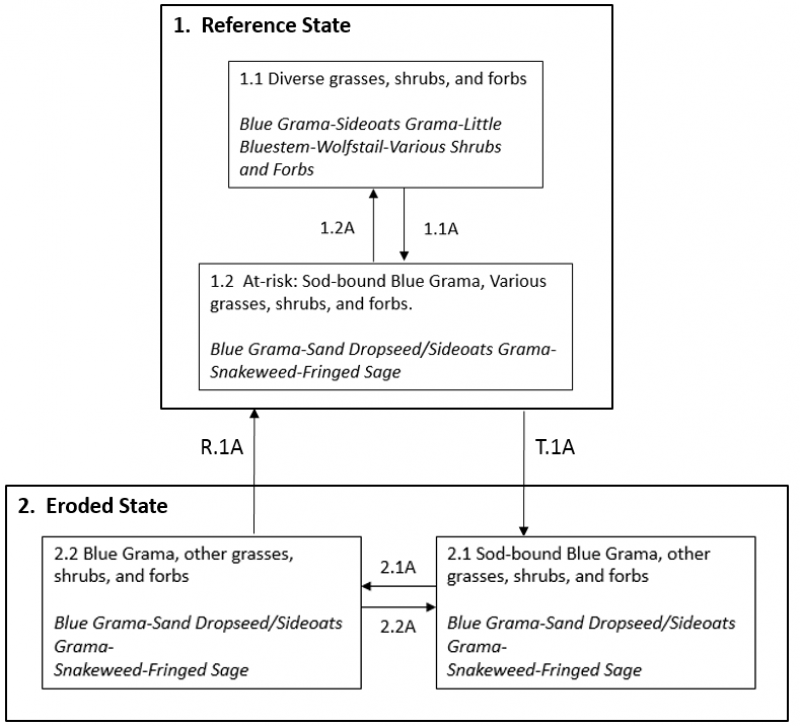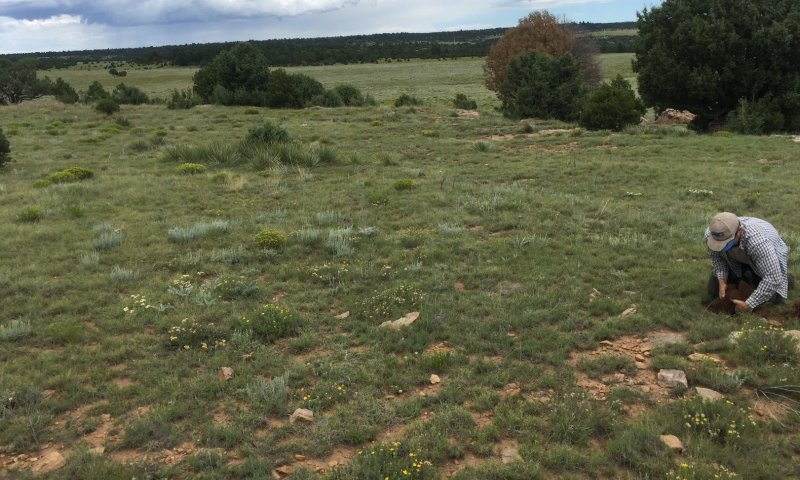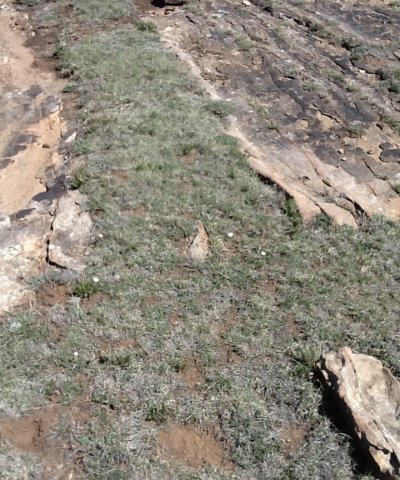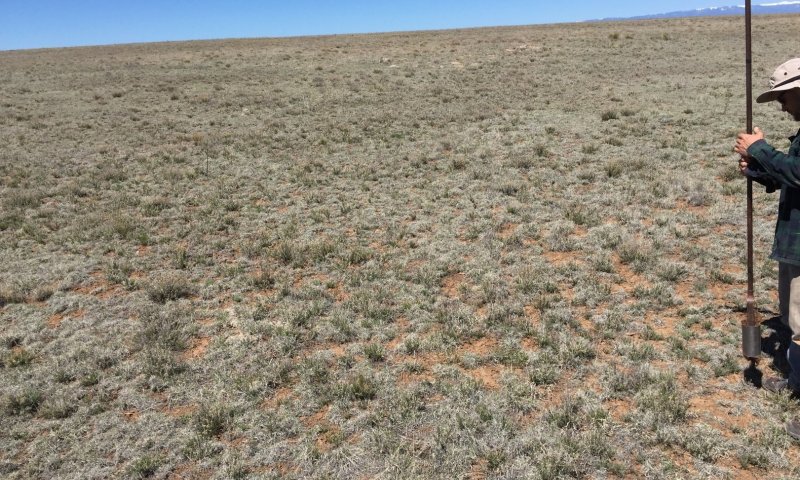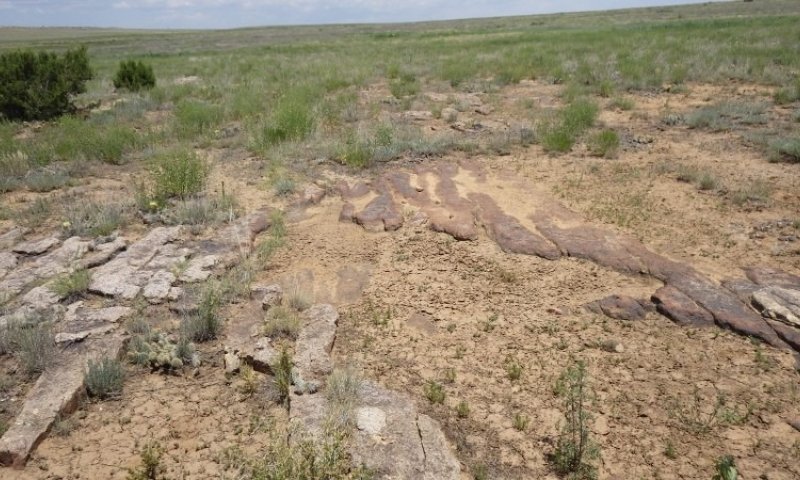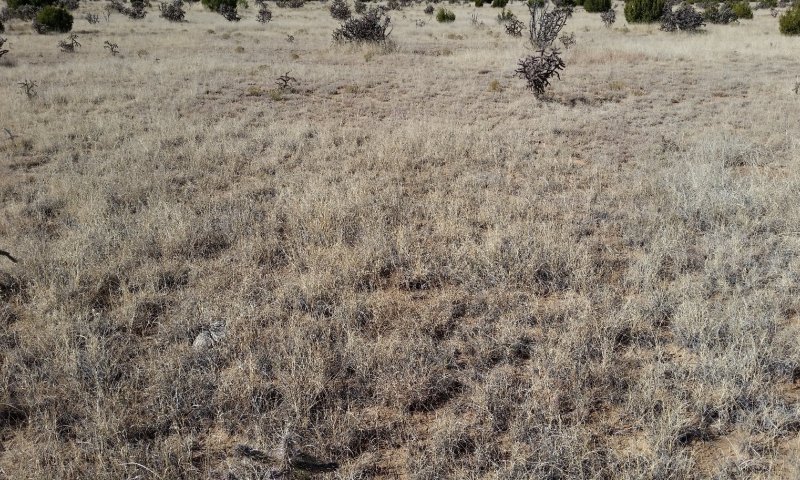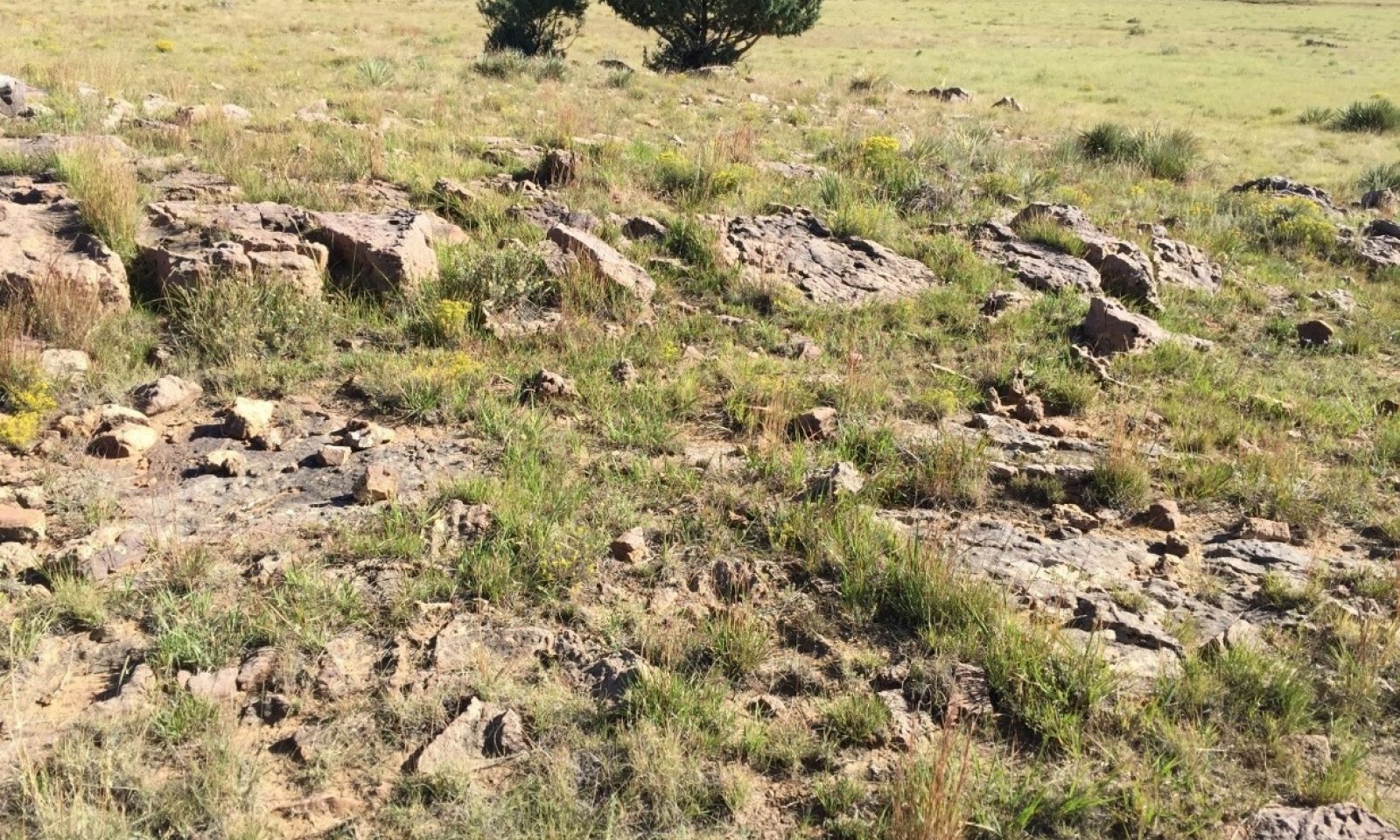

Natural Resources
Conservation Service
Ecological site GX070A01X013
Lithic Sandstone
Last updated: 10/01/2021
Accessed: 12/27/2024
General information
Provisional. A provisional ecological site description has undergone quality control and quality assurance review. It contains a working state and transition model and enough information to identify the ecological site.
MLRA notes
Major Land Resource Area (MLRA): 070A–High Plateaus of the Southwestern Great Plains
This site is only applicable to the Canadian Plateaus LRU of MLRA 70A (LRU 70A.1).
LRU notes
This site is only applicable to the Canadian Plateaus LRU of MLRA 70A (LRU 70A.1). Please refer to the following key:
Land Resource Unit (LRU) Key for MLRA 70A
– High Plateaus of the Southwestern Great Plains
1a. The site exists on a landform of volcanic origin, such as a basalt plateau, or is part of an escarpment system that rises directly to a volcanic structure. These escarpments are included if they have volcanic alluvium or colluvium (i.e. basalt, rhyolite, tuff, cinders) overlying non-volcanic residuum or bedrock (i.e. sandstone, shale). → VOLCANIC PLATEAUS LRU (VP)
User tip: Other alluvial or colluvial landform features extending below the escarpments are not included unless they have a predominance of volcanic fragments at the surface. Also, note that playas atop volcanic plateaus are included within the VP-LRU.
1b. All other sites. → 2
2a. The site exists in the annulus or floor of a playa. → CANADIAN PLATEAUS LRU (CP)
User tip: Small islands of playas occur within large areas of HP-LRU. These sites may be far from the nearest CP landform but will still key-out to the CP-LRU. The playa rim components, however, may key out to either LRU, so it is important to properly identify their soil properties.
2b All other sites. → 3
3a. The site is part of an escarpment landscape complex (defined below) or is within a canyon, valley, or small basin confined by such escarpments. At the upper boundary of the LRU, the soil surface meets at least 4 of the following 5 criteria:
I. Shallow or very shallow soils are present in at least 50% of the landform area;
II. Soils are underlain by sandstone bedrock of the Cretaceous Dakota Formation or older;
III. Presence or historical evidence of a conifer stand (≥ 2% canopy cover);
IV. The ground surface has a slope of at least 10%;
V. The landforms drain towards steep-walled escarpments or canyons below the Dakota sandstone (older Jurassic and Triassic Formations underlie this sandstone mesa cap).
→ MESOZOIC CANYONS AND BREAKS LRU (MCB)
User tip: The MCB sites also occur on any colluvial or alluvial bottomlands confined within escarpments or canyons. Some valleys transition from CP to MCB, or back to CP, and the turning point can be difficult to determine. Generally, the landforms are part of the MCB when confined between Dakota sandstone breaks or escarpments on both sides. Much of the acreage in the MCB is aproned by colluvial debris fans—composed of sandy materials with large sandstone fragments visible on the soil surface, including large stones or boulders. The soils in the bottoms of these confined valleys will also be in the MCB. When the valley opens, or there is only a single escarpment opening to the plains, the landforms below the steeper, rockier escarpments will be members of the CP-LRU.
3b. Fewer than 4 of the above criteria are met. → 4
4a. The soil is on a plateau summit position (tread) and is within 50 cm to contact with either plateau bedrock (non-soil bedrock of cemented sandstone, limestone, or shale) or strath terrace cobbles, but not a petrocalcic contact (caprock or caliche of cemented calcium carbonate). → CANADIAN PLATEAUS LRU (CP)
4b. No plateau bedrock or strath terrace cobbles within 50 cm. → 5
5a. Fragments (>2 mm) are visible within the soil profile and/or on the surface. If fragments cannot be found in the profile, it is acceptable to look nearby on ant mounds or around burrows. If site is in a drainageway, one can look for fragments on landforms immediately upslope.→ 6
5b. Fragments are entirely absent. → 7
6a. Fragments are mostly petronodes or High Plains gravels. → HIGH PLAINS LRU (HP)
6b. Fragments are mostly plateau bedrock fragments. → CANADIAN PLATEAUS LRU
7a. All horizons in the upper 100 cm of soil have textures of sandy clay loam or sandier.
→ CANADIAN PLATEAUS LRU (CP)
7b. At least one horizon in the upper 100 cm of soil has a texture that is less sandy than sandy clay loam. → HIGH PLAINS LRU (HP)
Classification relationships
NRCS and BLM: Lithic Sandstone Canadian Plateaus LRU Major Land Resource Area 70A, High Plateaus of the Southwestern Great Plains Land Resource Region G, Western Great Plains Range and Irrigated Region (United States Department of Agriculture, Natural Resources Conservation Service, 2006).
USFS: Lithic Sandstone Sandy Smooth High Plains Subsection Southern High Plains Section Great Plains-Palouse Dry Steppe Province (Cleland, et al., 2007).
EPA: Lithic Sandstone <26l Upper Canadian Plateau<26 Southwestern Tablelands (Griffith, et al., 2006).
Ecological site concept
The Lithic Sandstone ecological site occurs on plateau summits in the CP-LRU. The CP occupies the western portion of MLRA 70A and extends from Las Vegas, NM at the southern end to beyond Raton, NM at its northern end. Elevation for the CP LRU ranges from 5,000 to 7,500 feet.
Lithic Sandstone sites have soil depths that range from 4 to 20 inches to a bedrock contact with Cretaceous-aged Dakota sandstone that, at a minimum, is strongly cemented. Rock outcrop is visible somewhere on the site, or at least 10 percent surface fragments that are cobble sized (3 inches in diameter) or larger. The presence of bedrock or larger fragments at the surface creates abundant ecological micro-sites that increases the variability of plant and animal habitat. Surface textures are most often loam and fine sandy loam; stony loam occurs in one existing component and very stony sandy loam occurs in two. The soils of this site are distinguished from the soils of the Lithic Limestone ecological site in that they are underlain by sandstone rather than limestone bedrock and therefore some greater proportion of the parent materials are also derived from this bedrock. This results in soils that are sandier, redder in color, and lower total secondary carbonate content in subsurface horizons. Fragments are mostly non-calcareous.
Landscape: Plateaus
Landforms: Plateau Summits
Slope: 0 to 10 percent, but mostly under 5 percent
Aspect: Aspect does not exert much influence on this ecological site.
Associated sites
| GX070A01X008 |
Ephemeral Drainageways This site occurs on the channels and floodplains of ephemeral streams. Adjacent Lithic Sandstone sites contribute water to this site via run-on and through-flow. |
|---|---|
| GX070A01X021 |
Sandy This site occurs where soil depths are > 50 cm to a root restrictive layer and have surface textures of sandy loam or coarser and subsurface horizons of sandy clay loam or sandier. |
| GX070A01X017 |
Playas This site occurs in playas. Adjacent Lithic Sandstone sites can occur on playa rims and may contribute water to this site via run-on and through-flow. |
| GX070A01X002 |
Clayey Uplands This site occurs in soils that have high clay in subsurface horizons and exist on more stable landforms that have resisted erosion, or else they have subsurface horizons derived from shale residuum. |
| GX070A01X005 |
Limy This site occurs where soils surfaces have strong or violent effervescence and ≥ 5% calcareous rock fragments. There are little to no free carbonates at the surface of the Lithic Sandstone site. |
| GX070A01X003 |
Loamy Uplands These sites are deeper than 50 cm to bedrock contact. |
| GX070A01X004 |
Shallow Loamy This site occurs where soils have paralithic contact within 50 cm. |
| GX070A01X006 |
Slopes This site occurs on escarpments with slopes > 10%. These soils have bedrock at a depth ≤ 50cm that may or may not be lithic. |
| R070AA009NM |
Saline Playas This site occurs in discharge playas, typically at the lowest positions on plateaus. Adjacent Lithic Sandstone sites contribute water to this site via run-on and through-flow. |
| GX070A01X014 |
Lithic Limestone This site occurs where soils are = 75 cm to lithic contact with limestone bedrock, and often supports oneseed juniper savannahs. There is no limestone bedrock in the Lithic Sandstone site. |
Similar sites
| R070AY001NM |
Loamy Upland The Carnero components of this site are correlated to the Loamy Upland (R070AY001NM) site. This site fits deeper subsets of the Carnero components, but is a poor fit for soils less than 75 cm deep. Refer to the Future Work section below for more information on this issue. |
|---|---|
| R070AY003NM |
Shallow Upland The Bernal components of the Lithic Sandstone are currently correlated to the Shallow Upland (R070AY003NM) site. As noted above, the plant community described in this ESD seems to have been developed using data from hotter, drier areas than the CP, such as MLRAs 70B and 70C. |
Table 1. Dominant plant species
| Tree |
Not specified |
|---|---|
| Shrub |
Not specified |
| Herbaceous |
Not specified |
Legacy ID
R070AA013NM
Click on box and path labels to scroll to the respective text.

